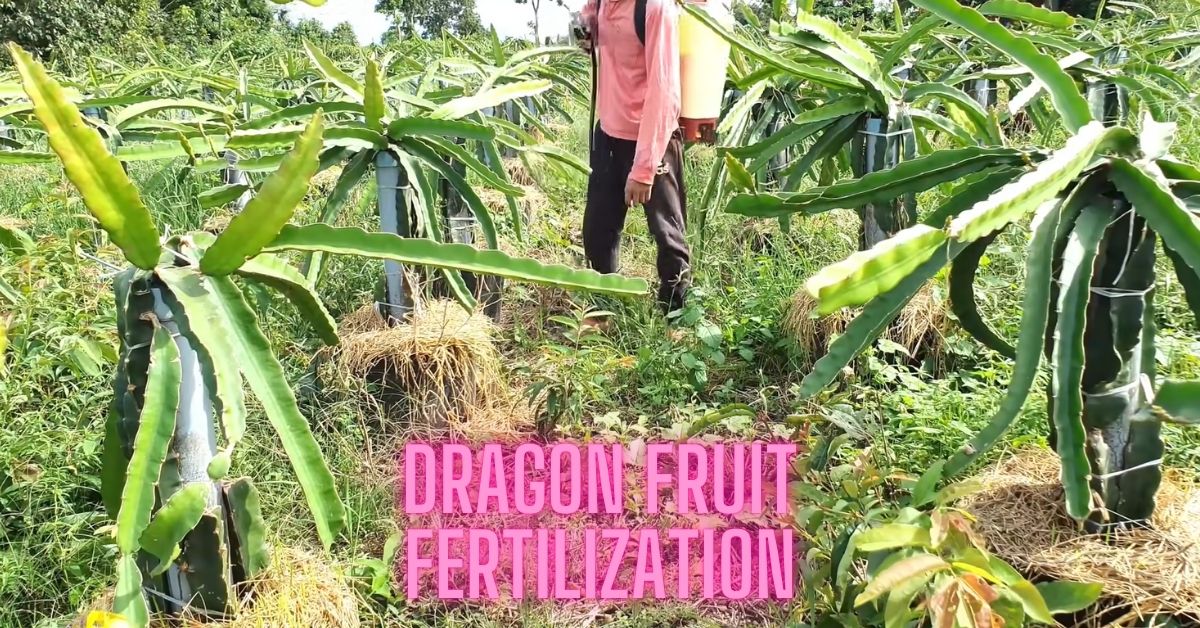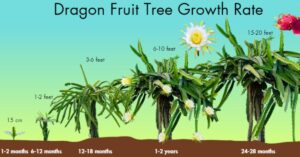
Dragon fruit, with its dazzling colors and distinctive taste, has become a favorite among home gardeners. But growing this exotic fruit requires more than just sunlight and warm weather. Proper fertilization is a key factor in achieving vigorous growth, abundant flowers, and plentiful harvests.
Understanding Dragon Fruit’s Nutritional Needs
To thrive, dragon fruit plants need a balanced supply of essential nutrients. These nutrients fall into three main categories:
1.Nitrogen (N): Vital for robust vegetative growth, nitrogen promotes lush foliage and healthy stems.
2. Phosphorus (P): This element supports strong root systems, sturdy stems, and prolific flowering.
3. Potassium (K): Potassium enhances plant health, boosts disease resistance, and aids in the development of high-quality fruits.
In addition to these macro nutrients, dragon fruit also benefits from micro nutrients like calcium, magnesium, and iron. These trace elements are crucial for various physiological processes, ensuring overall plant vitality and optimal fruit production.
Choosing the Right Fertilizer
Selecting the appropriate fertilizer is essential for meeting the specific needs of dragon fruit plants. Here are some popular options:
- Balanced Fertilizer: Formulations like 10-10-10 or 15-15-15 provide a steady supply of nitrogen, phosphorus, and potassium, making them suitable for most growth stages.
- Organic Fertilizers: Compost, manure, and bone meal release nutrients gradually, enriching the soil and promoting beneficial microbial activity.
- Specialized Fertilizers: Fertilizers formulated for cacti and succulents often have lower nitrogen levels and higher potassium levels, which are ideal for flowering and fruiting stages.
Fertilization Schedule
The timing and frequency of fertilization depend on the plant’s age, soil conditions, and overall health. Here’s a general guide:
- Young Plants: In their early growth phase, dragon fruit plants need regular fertilization to support vigorous vegetative development. Apply a balanced fertilizer every 4-6 weeks.
- Mature Plants: Once plants reach maturity and begin to flower, increase fertilization frequency to every 2-4 weeks during the growing season (spring to fall).
- Flowering and Fruiting: During these stages, use a fertilizer higher in potassium to encourage abundant flowers and fruit. Supplement with potassium-rich materials like banana peels or wood ash if needed.
Essential Nutrients for Dragon Fruit
| Nutrient | Role | Deficiency Symptoms |
| Nitrogen (N) | Vegetative Growth (leaves, stems) | Stunted growth, pale green leaves, reduced vigor |
| Phosphorus (P) | Root Development, Flowering, Fruiting | Poor root growth, weak stems, reduced flower production |
| Potassium (K) | Overall Plant Health, Disease Resistance, Fruit Quality | Weak stems, poor fruit development, susceptibility to diseases |
Important Considerations
1. Conduct a Soil Test: Testing the soil before fertilizing helps identify nutrient levels and deficiencies, allowing for tailored fertilization.
2. Avoid Over-Fertilization: Excess fertilizer can cause nutrient imbalances, root burn, or even plant death. Always adhere to the recommended application rates on the fertilizer label.
3. Ensure Proper Watering: Consistent watering aids nutrient absorption. Maintain moist, but not waterlogged, soil conditions.
4. Monitor Plant Health: Regularly inspect plants for signs of nutrient deficiencies (yellowing leaves, stunted growth) or excesses (leaf burn). Adjust your fertilization practices accordingly.
Signs of Nutrient Deficiencies
Understanding the symptoms of nutrient deficiencies can help you make timely corrections:
- Nitrogen Deficiency: Pale or yellowing leaves and slowed growth.
- Phosphorus Deficiency: Stunted growth and weak stems.
- Potassium Deficiency: Yellow or scorched leaf edges and poor fruit development.
Boosting Potassium Naturally
If your dragon fruit requires a potassium boost, consider these natural sources:
- Banana Peels: Chop and bury them near the plant base.
- Wood Ash: Sprinkle sparingly around the plant but avoid overuse, as it can alter soil pH.
- Compost: Rich in organic matter, compost provides potassium and other nutrients over time.
Adjusting for Soil Type
Dragon fruit thrives in well-draining, slightly acidic to neutral soil (pH 6-7). Depending on your soil type, you may need to make adjustments:
- Sandy Soil: Sandy soils drain quickly and may require more frequent fertilization to replenish lost nutrients.
- Clay Soil: Heavy clay retains nutrients but may need improved drainage. Incorporate organic matter to enhance aeration and nutrient availability.
Seasonal Adjustments
Dragon fruit’s nutritional needs vary with the seasons:
- Spring and Summer: Focus on balanced fertilization to support growth and flowering.
- Fall: Transition to high-potassium fertilizers to prepare plants for fruiting.
- Winter: Reduce or cease fertilization during dormancy, as the plant’s nutrient uptake slows.
Organic Fertilizer Advantages
Organic fertilizers not only supply nutrients but also improve soil structure and health. Here’s why they’re beneficial:
- Slow-Release: Nutrients are released gradually, reducing the risk of over-fertilization.
- Environmentally Friendly: Organic options are biodegradable and sustainable.
- Enhanced Microbial Activity: They promote a thriving soil ecosystem, beneficial for plant health.
Final Tips for Success
- Start with small amounts of fertilizer, especially if you’re uncertain about the plant’s needs.
- Always water after applying fertilizer to help nutrients penetrate the soil.
- Keep records of your fertilization schedule and plant responses to fine-tune your approach over time.
By understanding and addressing your dragon fruit plant’s nutritional needs, you’ll set the stage for healthy growth, vibrant blooms, and delicious harvests. Proper fertilization is an art and science, and with consistent care, your dragon fruit will reward you with its stunning beauty and delectable fruits.






amazing detailed
Thanks provide full Knowledge
Pingback: Turning Dragon Fruit Waste into Cattle Feed: A Sustainable Solution for Farmers 2025 -
Pingback: Grow Dragon Fruit: A Beginner's Guide to Backyard Cultivation 2025 -
Pingback: intergeneric hybridization: A Cytogenetic Study of Triploid and Aneuploid Hybrids 2025 -